
Tortoises are reptile species of the family Testudinidae of the order Testudines. They are particularly distinguished from other turtles by being exclusively land-dwelling, while many other turtle species are at least partly aquatic. Like other turtles, tortoises have a shell to protect from predation and other threats. The shell in tortoises is generally hard, and like other members of the suborder Cryptodira, they retract their necks and heads directly backwards into the shell to protect them.

Vachellia karroo, commonly known as the Sweet thorn, is a species of Vachellia, native to southern Africa from southern Angola east to Mozambique, and south to South Africa.
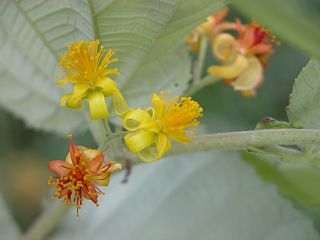
Grewia asiatica, commonly known as phalsa or falsa, is a species of flowering plant in the mallow family Malvaceae. It was first found in Varanasi, India, and was taken by Buddhist scholars to other Asian countries and the rest of the world. Grewia celtidifolia was initially considered a mere variety of phalsa, but is now recognized as a distinct species.

Mimetes chrysanthus is an evergreen, upright shrub of 1½–2 m high that has been assigned to the family Proteaceae. It has green, slightly stalked oval leaves of 3–4½ cm (1.2–1.8 in) long and 1–1¾ cm (0.4–0.7 in) wide. The inflorescences are near the tip of the branches, cylinder-shaped and consist of 50–70 densely cropped flower heads, each in the axil of a green leaf, consisting of 25–35 golden yellow, faintly sweet scented flowers. It is endemic to the Fynbos ecoregion of South Africa and is found in two locations, in the Western Cape province. The flowering season is from March to May or June, but flower heads sometimes occur in any other part of the year.

Mimetes cucullatus is an evergreen shrub with several, mostly not branching, upright stems of 1–2 m (3–7 ft) high, that has been assigned to the family Proteaceae. It is the most wide-spread and most common pagoda species that can cope with a relatively large range of environmental circumstances. It is known under several names including common pagoda in English and rooistompie in Afrikaans.

Mairia is a genus of perennial herbaceous plants assigned to the daisy family. All species have leathery, entire or toothed leaves in rosettes, directly from the underground rootstock, and one or few flower heads sit at the top of the stems that carry few bracts. These have a whorl of white to mauve ray florets surrounding yellow disc florets in the centre. In general, flowering only occurs after the vegetation has burned down. The six species currently assigned to Mairia are endemic to the Western Cape and Eastern Cape provinces of South Africa. Some of the species are called fire daisy in English and vuuraster in Afrikaans.

Chersobius boulengeri, commonly known as the Karoo padloper or Boulenger's cape tortoise, is a species of tortoise in the family Testudinidae. The species is endemic to the Nama Karoo Region of South Africa.
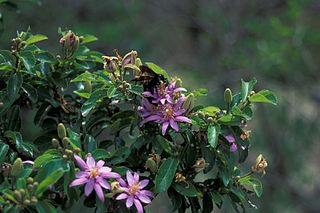
Grewia occidentalis, the crossberry, is a small, hardy, attractive tree indigenous to Southern Africa.
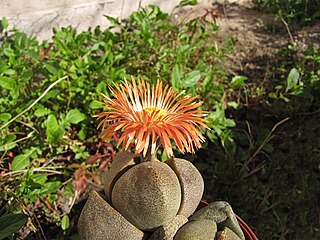
Pleiospilos nelii, the split rock, splitrock or living granite, is a species of flowering plant in the family Aizoaceae, native to South Africa. It grows in semi-arid areas with rainfall of between 150mm and 300mm, in the Karoo of South Africa.

Astroloba is a genus of flowering plants in the family Asphodelaceae, subfamily Asphodeloideae, native to the Cape Province of South Africa.

Muiria hortenseae ("mouse-head") is a rare dwarf species of succulent plant of the family Aizoaceae, indigenous to a very small area in the Little Karoo, Western Cape, South Africa. It is the only species in the monophyletic genus Muiria.

Astroloba foliolosa is a small succulent plant of the genus Astroloba widespread in the arid parts of the Eastern Cape Province, South Africa.
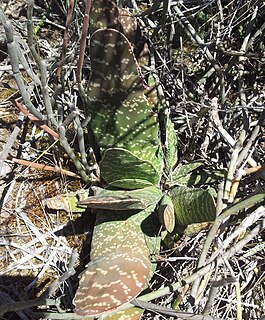
Gasteria disticha is succulent plant native to the Western Cape, South Africa.

Astroloba robusta is a small succulent plant of the genus Astroloba indigenous to the arid southern Cape regions of South Africa. It is the most widespread Astroloba species.

Cadaba aphylla ("Swartstorm") is one of some 30 species in the genus Cadaba. It is indigenous to southern Africa.

Leucospermum saxatile is an evergreen, rising to sprawling shrub of ½–¾ m high and 1–1½ m (3⅓–5 ft) wide, from the family Proteaceae. It has reddish tinged flowering stems and line-shaped, narrowing wedge-shaped leaves of 2½–5 cm(1–2 in) long and 2–5 mm (0.08–0.20 in) wide, with one to three blunt teeth, whorl-shaped, flat-topped, at first pale lime green but later carmine flower heads of 2½–3 cm across, mostly individually but sometimes grouped with two or three, each on a stalk. The flower heads occur from July to October. From the flowers occur long styles with a slightly thicker tip, which together give the impression of a pincushion. It is called Karoo pincushion in English. Flowering heads can be found from July until February. It naturally occurs in fynbos in the Western Cape province of South Africa.
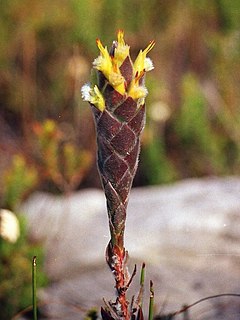
Mimetes palustris or cryptic pagoda is an evergreen shrub, assigned to the family Proteaceae. It has horizontal sprawling shoots as well as upright, unbranched shoots usually about ½ m high. The leaves are entire and stand out on the lower parts of the shoots, but are overlapping and pressed tightly against each other near the inflorescence, almost like a snakeskin. The inflorescence consists of several flowerheads, each containing three clear yellow flowers that are longer than the subtending leaves. It is the smallest species of Mimetes and is an endemic species that grows on well-drained, but permanently moist sandy and peaty slopes in the mountains near Hermanus, Western Cape province of South Africa. It is considered critically endangered. Flowering occurs all year round, but peaks in August and September.
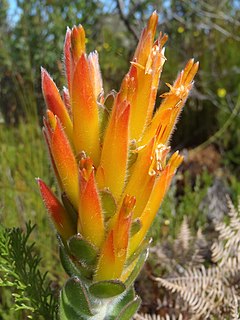
Mimetes pauciflorus, the three-flowered pagoda, is an evergreen, shyly branching, upright shrub of 2–4 (6½–13 ft) high, from the family Proteaceae. It has narrowly to broadly oval leaves of 2½–4 cm (1.0–1.6 in) long and ¾–2 cm (0.3–0.8 in) wide, on the upper parts of the branches, the lower parts leafless with a reddish brown bark. The inflorescences at the top of the shoots are cylinder-shaped, 10–40 cm (4–16 in) long and contain forty to one hundred twenty densely crowded flower heads, at a steep upward angle, hiding a crest of very small, almost vertical leaves. The flower heads each consist of three, rarely four individual flowers. The flowers are tightly enclosed by four or five orange-yellow, fleshy, pointy, lance-shaped involucral bracts, and three orange-yellow, 4–5½ cm (1.6–2.4 in) long bracteoles. It grows on always moist, south-facing slopes in the southern coastal mountains of South Africa. Flowers can be found from August to November, with a peak in September.
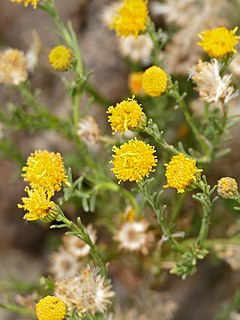
The African sheepbush is a plant native to South Africa and Namibia. It ranges throughout the Succulent Karoo, Nama Karoo, renosterveld, and fynbos, and it is listed under the SANBI Red List as "safe" (LC).
Protea restionifolia, which is also known as the Reed-leaf sugarbush, is a flowering shrub endemic to the Western Cape province of South Africa where it is found from the upper part of the Breede River Valley through the Bot River Valley to Wolseley and the Koue Bokkeveld Mountains.



















